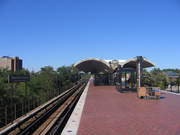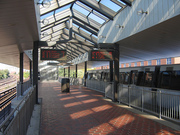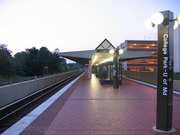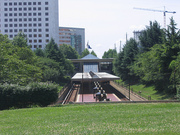Metro motifs, part 2: Above-ground stations
Monday, we looked at the designs of Metro’s underground stations and their signature vaults. The above-ground stations cannot have the large vaults, but Metro’s designers took steps to maintain architectural continuity.
Gull Wing I: In order to maintain the connectivity of the architectural elements of the system, the surface and elevated stations had a vault-like roof consisting of sweeping concrete ‘wings.’ I refer to this design as the Gull Wing I design. It is characteristic of the older outdoor stations.
The first Gull Wing I station opened on opening day in 1976, Rhode Island Avenue. The most recent station to receive this motif was the lower level of Fort Totten, which was not constructed at the same time as the Red Level, but in 1993, with the opening of the Line to Greenbelt.
All but two Gull Wing I stations have island platforms (platform is between the tracks). National Airport actually has two island Gull Wing I canopies separated by a center track. Cheverly and Eisenhower Avenue have side platforms, but still have the Gull Wing I roofs in a modified design. At National Airport, a canopy extension in the early 2000s did not keep the same style, so the station also features a unique design.
Gull Wing I designs can be found at 15 stations:
- 1976 — Rhode Island Avenue
- 1977 — National Airport* - (canopy extension installed in early 2000s does not match)
- 1978 — Brookland, Fort Totten (upper level), Takoma, Silver Spring, Minnesota Avenue, Deanwood, Cheverly, Landover, New Carrollton
- 1983 — Eisenhower Avenue
- 1984 — Twinbrook, Shady Grove
- 1991 — Van Dorn Street
- 1993 — Fort Totten (lower level, partial coverage)
Peaked Roof I: The next design, Peaked Roof I, is found at 2 stations only: Braddock Road and King Street in Alexandria, on the Blue and Yellow Lines. The Peaked Roof I design consists of a steeply sloped roof with skylights in the center.
Peaked Roof I appeared in 1983 with the opening of the Yellow Line extension to Alexandria. It’s interesting to note that when King Street’s canopy was extended a few years ago, the same architectural style was maintained, but a gap was left above King Street itself so as not to impede the view of the George Washington Masonic Tower.
Peaked Roof II: A more common design, Peaked Roof II can be found at many surface stations. It consists of a flat roof over the platform with a section of clear skylights forming a peak in the center (along a line parallel to the tracks).
This style was introduced with Grosvenor in 1984. Except for Van Dorn Street and the lower level of Fort Totten, it was the style of choice for the remainder of the Adopted Regional (103 mile) System, completed in 2001 with the extension to Branch Avenue.
Unlike Gull Wing I, there are no side platform stations with a Peaked II roof. West Falls Church has a modified design because of the third track in the center of the station. However, unlike National Airport, it does not have separate canopies, instead having one canopy stretching across all three tracks. The peaked Plexiglas panels run parallel to the tracks over both platforms.
Peaked Roof II can be found at 15 stations:
- 1980 — Addison Road
- 1984 — Grosvenor, White Flint, Rockville
- 1986 — East Falls Church, West Falls Church*, Dunn Loring, Vienna
- 1993 — College Park, Greenbelt
- 1997 — Franconia-Springfield
- 2001 — Southern Avenue, Naylor Road, Suitland, Branch Avenue
Gull Wing II: The newest design for the Metro returns to the gull-wing style, but differs greatly in many aspects from earlier designs. There are notable differences in color, materials, and motif elements. These stations are all of those constructed beyond the original system (which was completed in January of 2001). This design can be found at only 3 stations: New York Avenue on the Red Line and Morgan Boulevard and Largo Town Center on the Blue Line. All three of these stations opened in 2004.
Unique Designs: Several stations differ from these basic designs. They are worthy of mention because of their nonconformity. There are 5 unique stations in the system out of 86 stations total.
- 1977 — Arlington Cemetery (Blue)
- 1983 - Huntington (Yellow)
- 1991 — Anacostia (Green)
- 1993 — West Hyattsville, Prince George’s Plaza (Green)
Future Stations: The Silver Line, which will run from Stadium-Armory to Wiehle Avenue in Reston, will add at least one new architectural type to the system.
Next: Metro’s design motifs include more than just the roofs over each station. Pylons, tiles, canopies and more round out Metro’s ditinctive appearance.
Note: The nomenclature (Peaked Roof, etc.) for this post comes from Washington’s page at World.NYCSubway.org.










